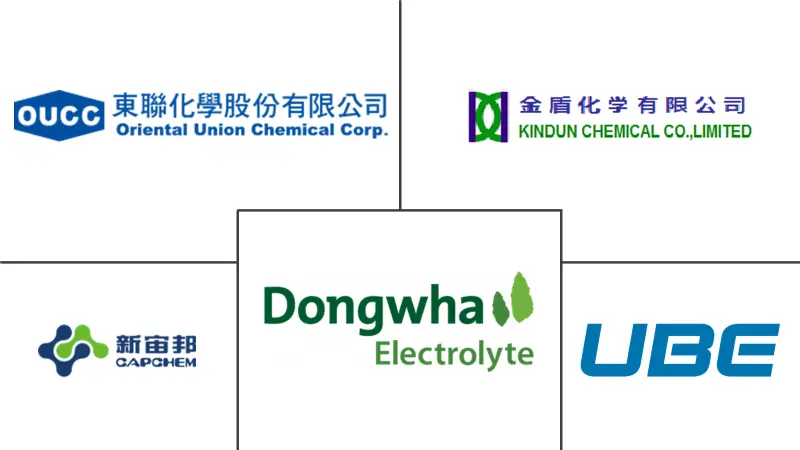Lithium-ion Battery's Electrolyte Solvent Market Size and Share
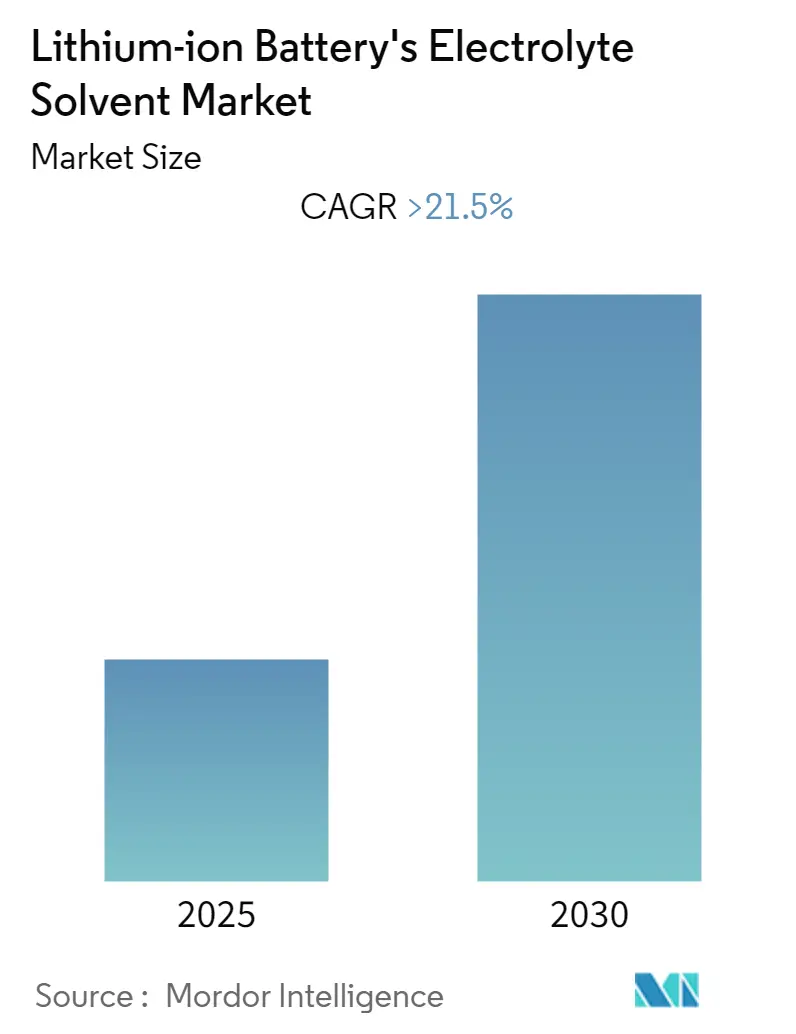
Lithium-ion Battery's Electrolyte Solvent Market Analysis by Mordor Intelligence
The Lithium-ion Battery's Electrolyte Solvent Market is expected to register a CAGR of greater than 21.5% during the forecast period.
The COVID-19 pandemic had a negative impact on the market, owing to the lockdown in various countries across the world led to supply chain constraints that significantly obstructed the expansion of the industry. Moreover, the production of automobiles and electronics observed a temporary halt which led to a decrease in demand for its major end-user industries. However, with improvement in the pandemic situation and the restart of automobile and electronic production operations, the market is now estimated to have reached pre-pandemic levels, and it is expected to grow steadily during the forecast period.
- The increasing demand from electric vehicle manufacturers and growing demand from smartphone manufacturers are likely to drive the demand for lithium-ion battery's electrolyte solvents.
- On the flip side, potential hazards caused by using impure electrolyte solvent is expected to hinder the growth of the market.
- Factors like emerging technologies in the production of non-flammable solvents and the increasing scope of lithium-ion batteries in aerospace applications are likely to offer numerous opportunities to the manufacturers during the forecast period.
- Asia-Pacific accounted for the largest share across the world, with China clearly dominating the global demand.
Global Lithium-ion Battery's Electrolyte Solvent Market Trends and Insights
Increasing demand from Electric Mobility/Vehicles Applications
- Electric mobility vehicles application is the fastest-growing application of the market studied. Lithium-ion batteries have a high power-to-weight ratio, which is the major advantage that is driving its growth in electric vehicle applications.vThe other advantages, such as high energy efficiency, good high-temperature performance, and low self-discharge, are also playing a part in improving EVs.
- Solvent is used in the batteries to adjust the concentration of the electrolyte, along with the formation of a protective layer between electrolyte and electrons.
- These solvents are mixed to decrease the electrolyte's viscosity and increase the solubility of lithium salts. This increases the mobility of lithium-ions in the electrolyte, resulting in higher battery performance in the vehicles.
- As per the EV Volumes, the global EV (electric vehicles) sales reached 6.75 million units in 2021, registering a growth of 108% compared to 3.24 million sales in 2020.
- Moreover, out of the 6.75 million EVs sold in 2021, 3.4 million EVs were sold in 2021 to mainland China, 2.3 million EVs were sold in Europe, and 0.7 million were in the United States. Moreover, the share of EVs (battery electric vehicles (BEVs) and plug-in hybrid electric vehicles (PHEVs)) in global light vehicle sales was 8.3 % in the year 2021 as compared to 4.2 % in 2020.
- According to IEA, in 2030, global electric vehicle sales are expected to reach 125 million as per the New Policies Scenario (excluding two/three-wheelers).
- Furthermore, As per the EV30@30 Scenario, in 2030, around 70% of the vehicle sales in China are expected to be EVs. Also, half of the vehicles sold in Europe are EVs, along with 37% in Japan, 30% in Canada and the United States, and 29% in India.
- With the high growth of the electric vehicle industry, along with government policy push in various countries, the solvent demand from electric vehicle battery application is expected to post the highest growth rates over the forecast period.
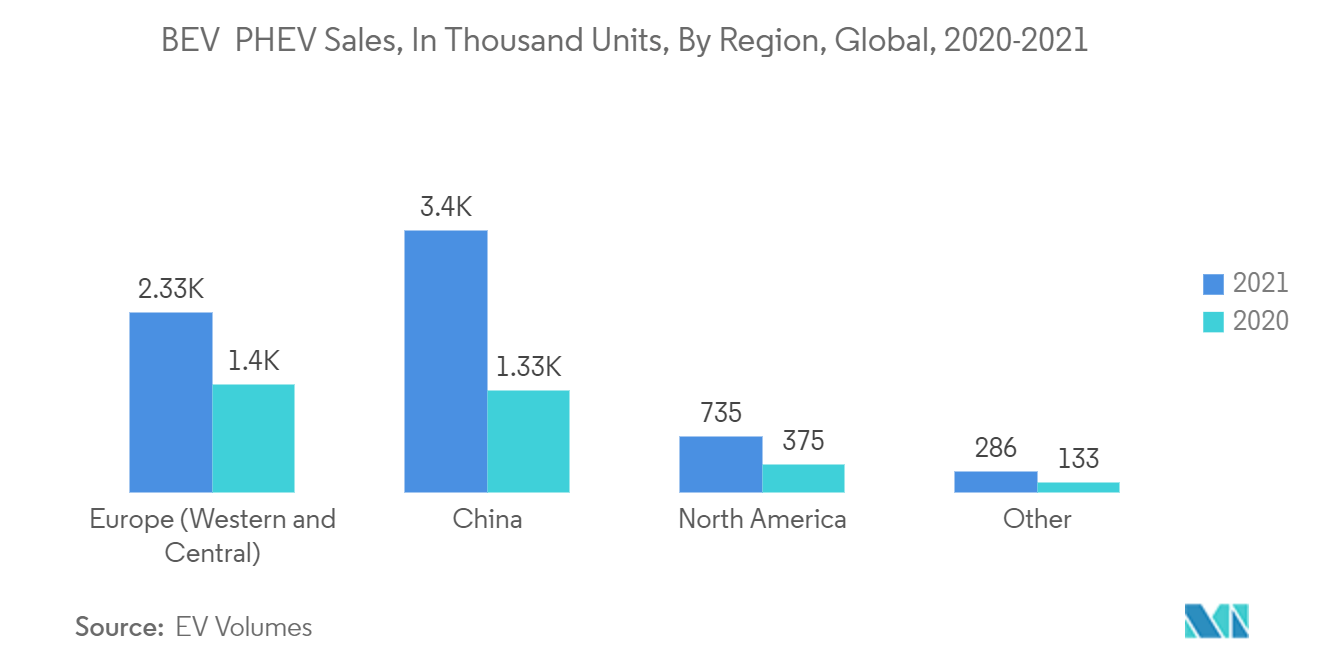
Asia-Pacific Region is Expected to Dominate the Market
- Asia-Pacific region is largest market for lithium-ion battery's electrolyte solvent and is expected to remain the largest market in the forecast period owing to significant demand for lithium-ion battery mainly for the application in automotive and electronics industries majorly form the China, India, and Japan.
- China is the largest car market for electric vehicles in the world. As per the EV Volumes, In China, the electric vehicle (battery electric vehicle (BEVs) and plug-in hybrid electric vehicle (PHEVs)) sales accounted for 3,396 thousand units, witnessing a growth of 155% compared to 1,331 thousand units, in 2020.
- Moreover, China has invested at least USD 60 billion to support the EV industry and it is pushing an ambitious plan to transition to all-electric or hybrid cars by 2035. China has predicted that approximately 50% of all cars sold by 2035 will exclusively be EVs.
- As per India Energy Storage Alliance (IESA), the Electric Vehicle (EV) industry in India is expected to expand at a CAGR of around 36% by 2030.
- Moreover, The Indian government has created momentum through its Faster Adoption and Manufacturing of (Hybrid and) Electric Vehicles schemes that encourage and, in some segments, mandate the adoption of electric vehicles (EV), to reach 30% EV penetration by 2030.
- The scheme creates demand incentives for EVs and supports the deployment of charging technologies and stations in urban centers.
- Although Japan plans to phase out petrol and diesel cars by the mid-2030s and is a powerhouse producer of hybrid cars, consumers have a limited choice when it comes to BEVs.
- Moreover, Japan also announced that it would stop the sale of new gasoline-only cars by 2035.
- The Japanese government is facing pushback from Toyota, which said last year that 'the current business model of the car industry is going to collapse' if the government moved too quickly. Toyota has no plans to mass-produce a BEV vehicle until 2025, although it is developing fuel-cell electric vehicles (FCEVs) that run on hydrogen.
- According to Japan Electronics and Information Technology Industries Association (JEITA), as of December 2021, the global production by the Japanese electronics and IT industry, including electronic equipment, components, devices, and others was estimated to register a growth of 8% year-on-year in 2021 to JPY 37,319.4 billion (~USD 281.09 billion) and the industrial production is forecasted to JPY 38,015.2 billion (~USD 286.33 billion) in 2022, with an estimated growth of 2% year-on-year.
- Thus, based on the aforementioned factors, Asia-Pacific is expected to dominate the global market over the forecast period.
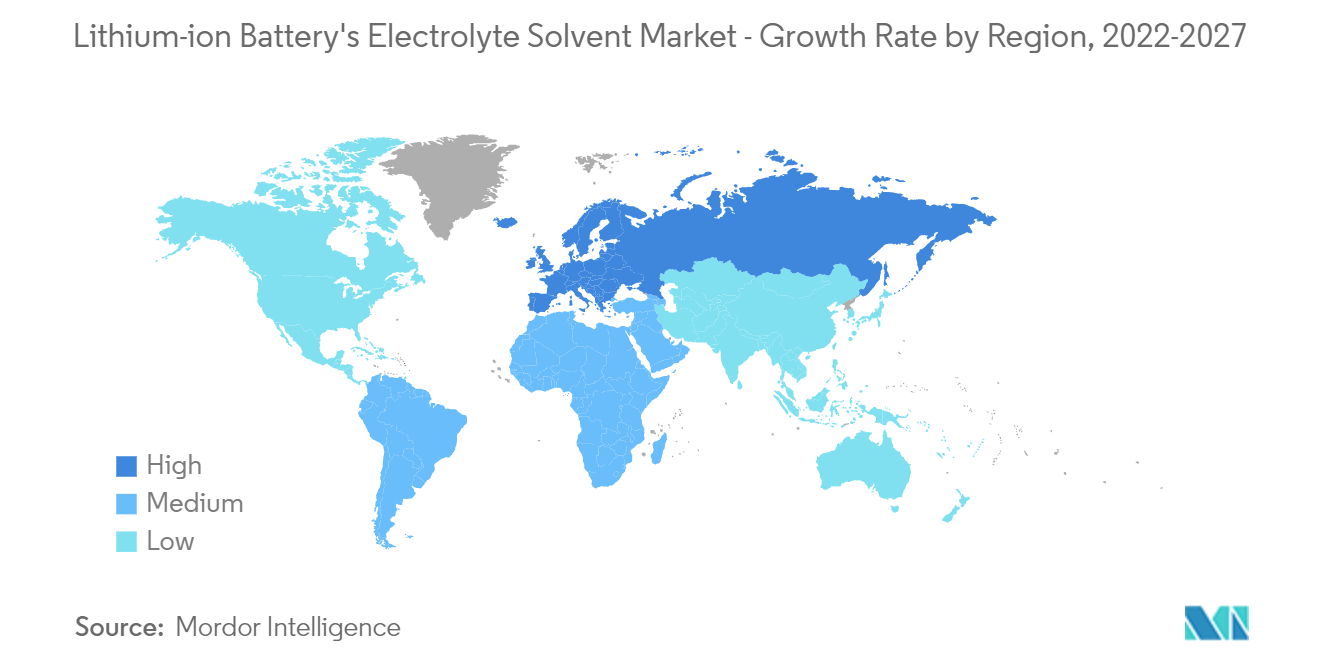
Competitive Landscape
The market studied is consolidated in nature. The major players in the market studied include (not in any particular order) UBE Corporation, Kindun Chemical Co., Limited, OUCC, Dongwha Electrolyte, and Shenzhen Capchem Technology Co. Ltd.
Lithium-ion Battery's Electrolyte Solvent Industry Leaders
-
UBE Corporation
-
Kindun Chemical Co., Limited
-
OUCC
-
Dongwha Electrolyte
-
Shenzhen Capchem Technology Co. Ltd.
- *Disclaimer: Major Players sorted in no particular order
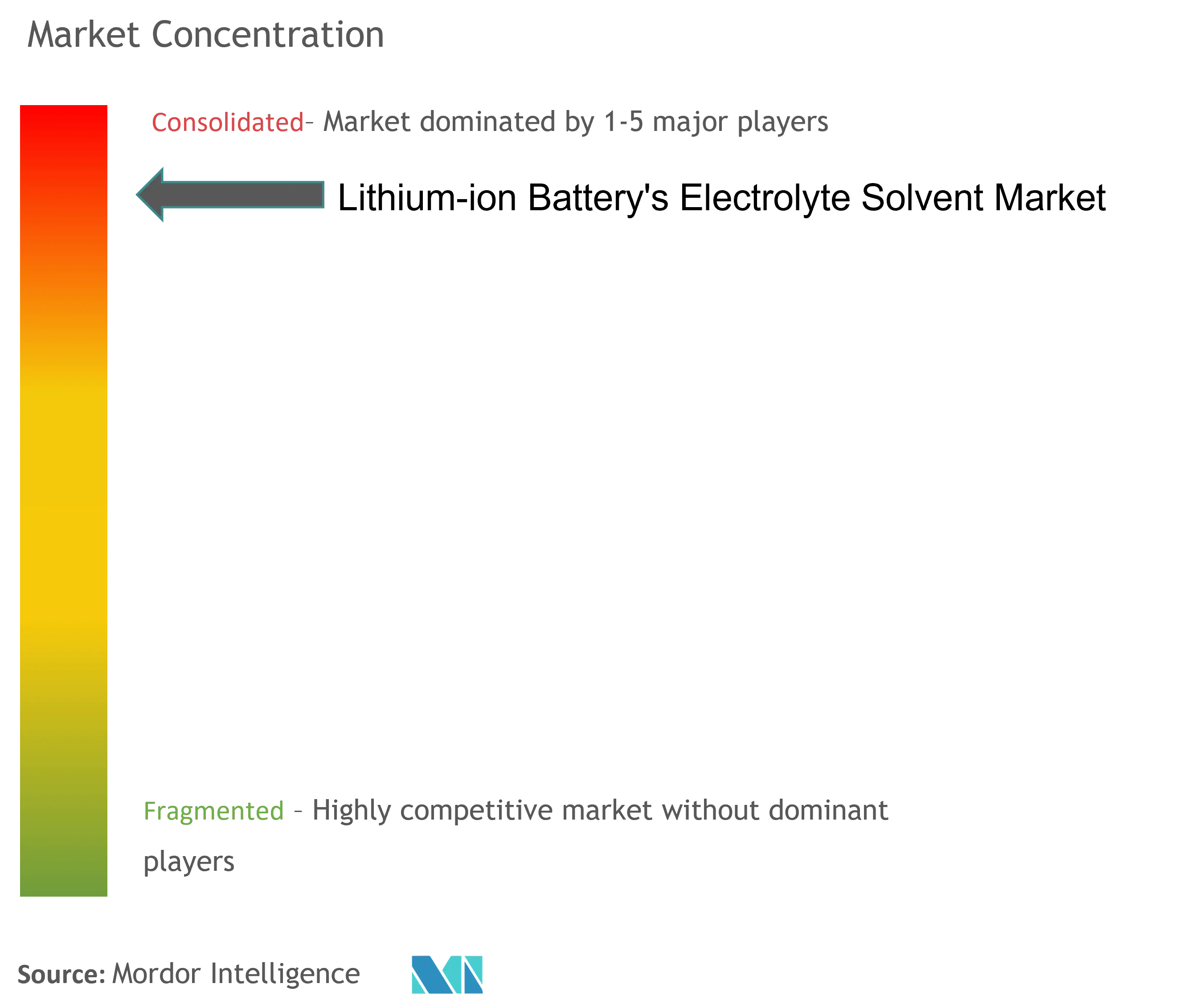
Recent Industry Developments
- In July 2022, UBE Corporation started the study for the feasibility of a construction site to produce Dimethyl Carbonate (DMC) and Ethyl Methyl Carbonate (EMC) in Louisiana, United States which are the principal component of the solvent for electrolytes in lithium-ion batteries. The company planned a production plant with a planned production capacity of 100,000 metric tons per year of DMC and 40,000 metric tons per year of EMC for which the company is planning a final investment decision by the first half of fiscal 2023, and operations to commence in the second half of fiscal 2025.
- In February 2022, South Korean company Lotte Chemical, announced an investment of KRW 602 billion (~USD 502 million) in its eco-friendly and specialty material business. The investment will be used for building a new plant to produce high-purity organic solvents, such as ethylene carbonate and dimethyl carbonate, which are used for lithium-ion battery electrolytes.
Global Lithium-ion Battery's Electrolyte Solvent Market Report Scope
Electrolytes are vital components of an electrochemical energy storage device. They are usually composed of a solvent or mixture of solvents and a salt or a mixture of salts, which provide the appropriate environment for ionic conduction. The lithium-ion battery's electrolyte solvent market report is segmented by solvent type, application, and geography. By solvent type, the market is segmented into, ethylene carbonate, diethyl carbonate, dimethyl carbonate, ethyl methyl carbonate, propylene carbonate, and other solvent types. By application, the market is segmented into application power backups/UPS, mobile, laptops, and other commonly used consumer electronic goods, electric mobility/vehicles, energy storage systems, and other applications. The report also covers the size and forecasts for the lithium-ion battery's electrolyte solvent market in 15 countries across the major regions. For each segment, the market sizing and forecasts have been done based on revenue (USD million).
| Ethylene Carbonate (EC) |
| Diethyl Carbonate (DEC) |
| Dimethyl Carbonate (DMC) |
| Ethyl Methyl Carbonate (EMC) |
| Propylene Carbonate (PC) |
| Other Solvent Types |
| Power Backups/UPS |
| Mobile, Laptops, and Other Commonly Used Consumer Electronic Goods |
| Electric Mobility/Vehicles |
| Energy Storage Systems |
| Other Applications |
| Asia-Pacific | China |
| India | |
| Japan | |
| South Korea | |
| ASEAN Countries | |
| Rest of Asia-Pacific | |
| North America | United States |
| Canada | |
| Mexico | |
| Europe | Germany |
| France | |
| United Kingdom | |
| Italy | |
| Rest of Europe | |
| South America | Brazil |
| Argentina | |
| Rest of South America | |
| Middle-East and Africa | Saudi Arabia |
| South Africa | |
| Rest of Middle-East and Africa |
| Solvent Type | Ethylene Carbonate (EC) | |
| Diethyl Carbonate (DEC) | ||
| Dimethyl Carbonate (DMC) | ||
| Ethyl Methyl Carbonate (EMC) | ||
| Propylene Carbonate (PC) | ||
| Other Solvent Types | ||
| Application | Power Backups/UPS | |
| Mobile, Laptops, and Other Commonly Used Consumer Electronic Goods | ||
| Electric Mobility/Vehicles | ||
| Energy Storage Systems | ||
| Other Applications | ||
| Geography | Asia-Pacific | China |
| India | ||
| Japan | ||
| South Korea | ||
| ASEAN Countries | ||
| Rest of Asia-Pacific | ||
| North America | United States | |
| Canada | ||
| Mexico | ||
| Europe | Germany | |
| France | ||
| United Kingdom | ||
| Italy | ||
| Rest of Europe | ||
| South America | Brazil | |
| Argentina | ||
| Rest of South America | ||
| Middle-East and Africa | Saudi Arabia | |
| South Africa | ||
| Rest of Middle-East and Africa | ||
Key Questions Answered in the Report
What is the current Lithium-ion Battery's Electrolyte Solvent Market size?
The Lithium-ion Battery's Electrolyte Solvent Market is projected to register a CAGR of greater than 21.5% during the forecast period (2025-2030)
Who are the key players in Lithium-ion Battery's Electrolyte Solvent Market?
UBE Corporation, Kindun Chemical Co., Limited, OUCC, Dongwha Electrolyte and Shenzhen Capchem Technology Co. Ltd. are the major companies operating in the Lithium-ion Battery's Electrolyte Solvent Market.
Which is the fastest growing region in Lithium-ion Battery's Electrolyte Solvent Market?
Europe is estimated to grow at the highest CAGR over the forecast period (2025-2030).
Which region has the biggest share in Lithium-ion Battery's Electrolyte Solvent Market?
In 2025, the Asia-Pacific accounts for the largest market share in Lithium-ion Battery's Electrolyte Solvent Market.
What years does this Lithium-ion Battery's Electrolyte Solvent Market cover?
The report covers the Lithium-ion Battery's Electrolyte Solvent Market historical market size for years: 2019, 2020, 2021, 2022, 2023 and 2024. The report also forecasts the Lithium-ion Battery's Electrolyte Solvent Market size for years: 2025, 2026, 2027, 2028, 2029 and 2030.
Page last updated on:
Lithium-ion Battery's Electrolyte Solvent Market Report
Statistics for the 2025 Lithium-ion Battery's Electrolyte Solvent market share, size and revenue growth rate, created by Mordor Intelligence™ Industry Reports. Lithium-ion Battery's Electrolyte Solvent analysis includes a market forecast outlook for 2025 to 2030 and historical overview. Get a sample of this industry analysis as a free report PDF download.
